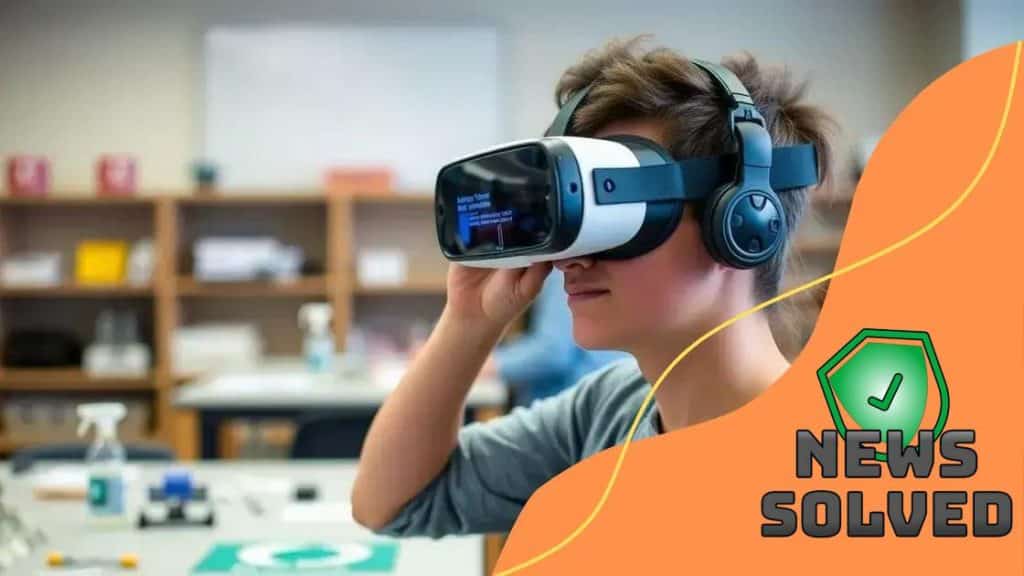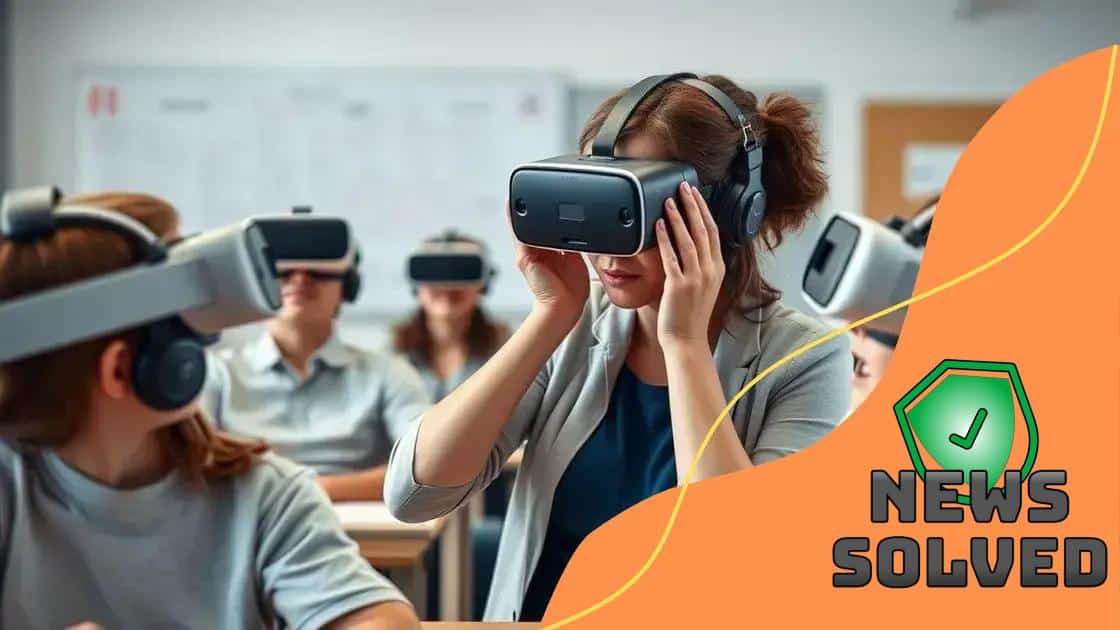The impact of virtual reality on college-level STEM courses

Advertisements
The impact of virtual reality on college-level STEM courses enhances learning through immersive experiences, improved collaboration, and personalized education, while also facing challenges like cost and the need for effective implementation.
The impact of virtual reality on college-level STEM courses is transforming how students learn. Imagine stepping into a simulated lab where physics comes alive! This innovative approach not only boosts engagement but also enriches learning.
Advertisements
Understanding virtual reality in education
Understanding virtual reality in education is essential as it opens new avenues for teaching and learning. This immersive technology allows students to engage in ways that traditional methods cannot replicate. By placing learners in simulated environments, they can experience concepts firsthand, which enhances their grasp of complex subjects.
What is Virtual Reality?
Virtual reality refers to a technology that creates a simulated environment, allowing users to interact with three-dimensional spaces. In an educational context, it offers tools for students to visualize and manipulate scientific phenomena or historical events.
Benefits of Virtual Reality in Education
- Enhances engagement through interactive experiences.
- Facilitates understanding of difficult concepts with visual simulations.
- Encourages experiential learning, making lessons more memorable.
- Provides safe environments for practice and exploration.
Furthermore, the use of VR can democratize education. Students from various backgrounds can access the same high-quality learning materials, regardless of their geographical locations. Imagine a classroom where students can journey through the solar system or explore the human body without ever leaving their seats!
Advertisements
In addition, VR experiences can be tailored to suit different learning styles. Some students may thrive in visual settings, while others might benefit from hands-on simulations. By incorporating virtual reality, educators can create personalized learning paths that accommodate diverse needs.
Challenges of Implementing Virtual Reality
Despite its benefits, implementing virtual reality in educational settings comes with challenges. Budget constraints may limit access to necessary technology. Moreover, teachers need proper training to effectively integrate VR into their lessons. Still, solutions exist. Schools can collaborate with tech companies or seek grants to secure funding.
Ultimately, understanding how to utilize virtual reality can transform the educational landscape. It can foster a more engaging and interactive learning environment that prepares students for a rapidly evolving future.
How VR enhances STEM learning experiences
Virtual reality (VR) significantly enhances STEM learning experiences by immersing students in interactive educational environments. These innovative tools allow learners to dive deep into topics like physics, biology, and engineering, where theories come to life.
Immersive Learning Environments
One of the main advantages of VR in education is its ability to create immersive learning environments. For instance, students can explore the human anatomy or engage with complex mathematical problems in a 3D space, making abstract concepts tangible. This visual representation fosters deeper understanding and retention.
Hands-On Experience
- Students can perform virtual experiments without the fear of real-world consequences.
- They can manipulate variables in simulations, observing outcomes in real-time.
- VR provides opportunities for practice in safe and controlled settings.
- Users can explore intricate machines or ecosystems up close.
Moreover, virtual reality can improve critical thinking and problem-solving skills. By tackling challenges in a simulated world, students learn to strategize and think analytically. This hands-on experience boosts confidence in applying theoretical knowledge to real-world scenarios.
Another key benefit is that VR enables collaborative learning. Students can work together in virtual spaces, regardless of their physical locations, fostering teamwork and communication skills. Imagine students from different parts of the world working on a joint project in a shared virtual laboratory!
Customization and Accessibility
Furthermore, VR can be customized to fit the unique learning needs of each student. Whether a learner prefers visual aids or hands-on engagements, VR can cater to various styles, ensuring that all students can thrive. Accessibility is another crucial factor; students with disabilities benefit immensely from VR experiences, as many technologies can be tailored to accommodate different needs.
Ultimately, the integration of virtual reality into STEM education reshapes learning experiences. By bridging the gap between theory and practice, students become more engaged and motivated to explore science and technology topics.
Challenges of integrating VR into STEM courses

Integrating virtual reality into STEM courses presents several challenges that educators must navigate. These obstacles can impact the effectiveness of VR technology in enhancing learning experiences.
Cost of Technology
One of the primary challenges is the cost of technology. High-quality VR headsets and software can be expensive, making it difficult for some educational institutions to invest in the necessary equipment. Limited budgets often restrict the availability of VR resources.
Training and Expertise
Another significant hurdle is the need for proper training and expertise among educators. Teachers must be familiar with VR systems to use them effectively in their lessons. Without sufficient training, they may struggle to incorporate this technology into their teaching strategies, limiting its potential benefits.
- Professional development programs are essential for teacher training.
- Access to resources and workshops can help boost confidence in using VR.
- Collaboration with tech experts can facilitate the learning process.
Moreover, educators face the challenge of designing effective VR content that aligns with curriculum standards. Creating engaging and relevant VR experiences requires time and effort, which teachers often lack due to their existing workload.
Additionally, ensuring student access to VR technology can be problematic. Students may not have access to VR devices outside of school, which could create disparities in learning. This digital divide can hinder students’ ability to engage with VR lessons fully.
Technical Issues
Technical issues can also complicate the integration of virtual reality. Software glitches, hardware malfunctions, and connectivity problems can disrupt lessons and frustrate both teachers and students. Schools need strong technical support to address these challenges quickly.
Lastly, some educators may have concerns about student motion sickness or discomfort while using VR. This can deter them from fully embracing this technology in their classrooms. Teachers must be mindful of their students’ experiences and adjust sessions to ensure comfort and safety.
Real-world applications of VR in STEM
Virtual reality (VR) has numerous real-world applications in STEM fields, revolutionizing how professionals and students engage with technology and concepts. These applications extend beyond the classroom and into various industries where simulation and immersive experiences can make a significant impact.
Healthcare Training
In the healthcare sector, VR is transforming the way medical students and professionals are trained. With VR, they can participate in realistic simulations of surgeries and patient interactions. This immersive training allows students to practice critical skills in a safe environment before working with real patients.
Engineering and Design
Engineers and designers use VR to visualize complex projects in 3D space. This technology enables them to explore different design options and make modifications before construction begins. With VR, teams can collaborate on projects remotely, reviewing and altering designs together in real time.
- Enhances understanding of spatial relationships between components.
- Facilitates testing of prototypes in a virtual environment.
- Reduces errors by allowing for thorough analysis and adjustments before implementation.
Additionally, VR is used in architectural design, where clients can experience a building layout before completion. This helps in gathering feedback and making necessary changes early in the process.
Scientific Research
In scientific research, VR is invaluable for visualizing data, particularly in fields like biology and physics. Researchers can create simulations of complex systems, such as climate models or molecular interactions. These virtual environments allow for deeper analysis and understanding of intricate concepts.
Moreover, VR can promote collaboration among scientists worldwide. By sharing virtual models, researchers can work together on projects, leading to innovative solutions to global challenges.
Education and Training
Beyond higher education, VR applications extend to corporate training as well. Companies can use VR for employee onboarding and ongoing training. Employees can engage in realistic job scenarios, improving their skills and confidence before facing challenges in their roles.
Overall, virtual reality in STEM offers benefits that enhance learning, streamline processes, and foster collaboration across various fields. Whether in healthcare, engineering, or scientific research, VR continues to shape the future of how professionals work and learn.
Future trends of VR in higher education
The future trends of virtual reality (VR) in higher education promise exciting advancements that can reshape the learning landscape. As technology evolves, educators are exploring innovative ways to enhance the student experience through immersive learning environments.
Increased Accessibility
One prominent trend is increased accessibility. As VR technology becomes more affordable, universities can invest in equipment that is available to more students. This democratization of technology allows a wider range of learners to experience immersive educational content. Imagine students from diverse backgrounds having the same opportunities to engage in simulations and hands-on learning.
Integration with Artificial Intelligence
Another trend is the integration of VR with artificial intelligence (AI). This combination can lead to personalized learning experiences. For example, AI can track a student’s progress and adapt VR simulations to meet their specific learning needs. This tailored approach can enhance understanding and retention of complex topics.
- AI can provide real-time feedback during VR sessions.
- Personalized pathways can be created based on individual performance.
- Adaptive learning environments can respond to student needs dynamically.
Moreover, the development of virtual campuses can further expand educational offerings. Universities can create comprehensive online environments where students can attend classes, interact with peers, and participate in group activities, all within a virtual space. This can enhance remote learning and provide a sense of community for online students.
Collaboration and Global Learning
Future VR applications will likely focus on collaboration and global learning. Students from different countries can participate in joint projects within virtual environments. This exposure to diverse perspectives enriches the learning experience. Collaborative VR workshops can also facilitate teamwork, preparing students for real-world interactions in a globalized workforce.
Lastly, gamification within VR education will grow. By incorporating game-like elements, educators can increase engagement and motivation. Interactive challenges and rewards can create a fun and stimulating learning environment, making complex subjects more approachable.
As we look to the future, the potential for virtual reality in higher education is vast. Innovations will continue to enhance learning, create global connections, and prepare students for the challenges of tomorrow.
In conclusion, the future of virtual reality in higher education looks promising. As technology advances, VR will become more accessible, affordable, and integrated into various learning environments. The potential for immersive experiences to enhance education is vast, allowing for greater collaboration among students from different backgrounds. By embracing these innovative tools, educators can create dynamic learning experiences that prepare students for the challenges of tomorrow. Overall, VR has the power to transform the learning landscape, making education more engaging and effective.
FAQ – Frequently Asked Questions about Virtual Reality in Higher Education
How can virtual reality enhance learning in STEM fields?
Virtual reality creates immersive experiences that allow students to visualize complex concepts, perform hands-on simulations, and engage interactively with the material.
What are the main challenges of integrating VR in higher education?
Some challenges include high costs of equipment, the need for teacher training, creating effective VR content, and ensuring equitable access for all students.
What future trends can we expect for VR in education?
We can anticipate greater accessibility, AI integration for personalized learning, increased global collaboration among students, and gamification to boost engagement.
How does VR contribute to collaboration among students?
VR enables students from different locations to participate in shared virtual environments, enhancing teamwork and allowing for diverse perspectives in learning.





